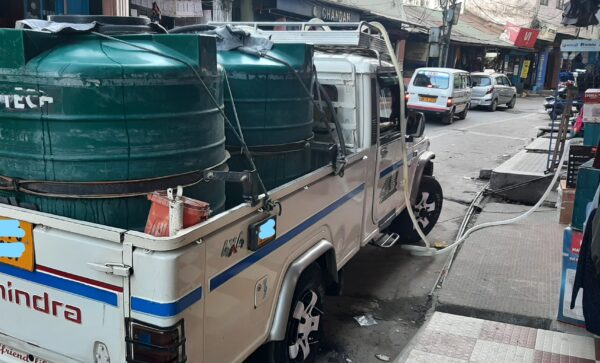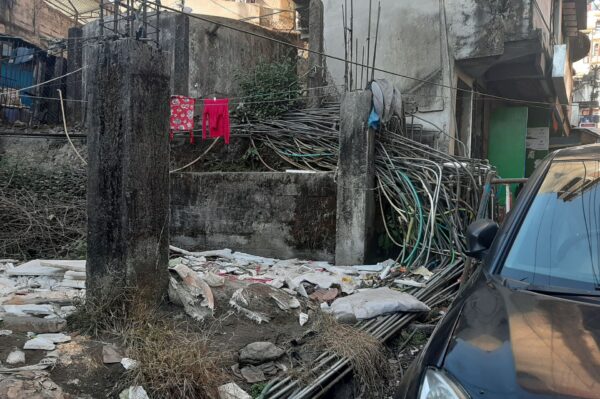Kalimpong is synonymous with water woes for many years now. With an increase in the local and immigrant population, the town has witnessed unprecedented and unplanned urbanization of its fragile landscape. While infrastructure development has not been able to keep pace with this trend, climate change has also affected the local weather conditions. Monsoons are more erratic and unreliable than ever. Addressing the water crisis of Kalimpong is becoming a mounting challenge for the local and state administrations.
Located in the Eastern Himalayas in West Bengal in India, urban Kalimpong is strategically placed between two hills, Deolo and Durpin. The municipality area constitutes 23 administrative wards spanning 9.17 sq km and has a total population of 49,403 (2011 census).
Water supply of the town is primarily catered to by Neora, Relli and Thukchuk rivers which is fed into a reservoir at Deolo. From there, it is distributed through pipelines every alternate day for half an hour. In the lean season, the crisis hits a peak when water supply gets restricted to once in 3-4 days.
While the total urban water demand stands at 2.3 mgd (million gallons per day), the supply by NWSM (Neora Water Supply and Maintenance Division) has fallen to 0.4 mgd or 31.5 litres/person/day. This huge disparity in water demand and supply at household (HH) level has forced people to seek supplementary options like dhara (seasonal and perennial spring), storing water harvested in monsoons and buying water from private suppliers (Rs.175 for 500 liters).
These suppliers ferry water in water tanks from jhoras (streams) located in the periphery of the town. A decent part of HH income goes into buying water which otherwise is a free basic service. The socio-economically marginalized communities are the worst affected suffering from mental and physical stress in the struggle to meet their day-to-day water needs.

(photo taken on 06.02.2021)
As more and more vegetation land that served as catchments area is being replaced with concrete houses, several dharas and jhoras have dried up, some permanently. Most of the feeder supply lines are poorly maintained and a considerable amount of water gets lost from leakages.
The problem gets worsened when wastes (includes biomedical and sanitary wastes) seeps into the old rusty water pipelines. Water quality is poor with coliform (bacteria) infestation leading to rising instances of diarrhoea, dysentery, cholera, gastritis, and other water-borne ailments every year.
Aggravating this water crisis is the gradual change in the pattern of monsoon rainfall which is noticeably scanty some years, mainly due to climate change. Monsoon water is solely responsible for replenishing the groundwater for mountain towns like Kalimpong. There is no proper mechanism to store rainwater which gets lost as surface runoff. In August 2020, a flash flood affected an entire street in the center of the town and claimed a life in the outskirts.
The water crisis of Kalimpong is worsening with every passing year. For the resident population, even the basic civic amenities seem farfetched. The dying of springs and river catchments is an additional challenge for the administrators and residents of Kalimpong, and therefore needs urgent conservation measures.
It is highly imperative that techniques (scientific as well as indigenous) on climate change adaptation and mitigation strategies be considered. Unless a significant and impactful solution is sought and implemented, a collapse of the entire infrastructure is imminent in the near future. This beautiful hill station is under great threat and we must act now to safeguard its existence.



Very good article. I certainly appreciate this website. Keep writing!
Ways to store rainwater and conserve water from dhara’s?
Thank you for your comment! Well, the first thing that needs to be taken care of is the rapid pace of deforestation in these hills. There is a need for stricter measures to prevent deforestation and construction, especially in areas surrounding the dharas (or any other catchment area), which will in turn prevent the drying of these renewable sources. Coming to the rainwater storage techniques, one can always opt for rainwater harvesting. It is a small-scale, quick and easy procedure that can be practiced by any household. On a larger scale, more reservoirs can be built to collect rainwater and distribute it during the lean season. These are some of the quick fixes that can be done in the near future, but in the long run, strategic sustainable planning is needed in order to sustain the rising population in these Himalayan hills.